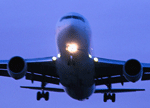The Australian Transport Safety Bureau (ATSB) released its final report last week of an United Arab Emirates (UAE) aircraft tail-strike incident at Melbourne Airport, Victoria, Australia on the 20th of March. I blogged a bit about this back in May.
The UAE Airbus A340-541 aircraft was leaving on a 14 hour flight to Dubai with 257 passengers, 14 cabin crew and 4 flight crew.
According to the final report, "During the reduced thrust takeoff, the aircraft’s tail made contact with the runway surface, but the aircraft did not begin to climb. The captain commanded and selected take-off and go-around engine thrust and the aircraft commenced a climb. After jettisoning fuel to reduce the landing weight, the flight crew returned the aircraft to Melbourne for landing."
The ATSB confirmed its preliminary findings that determined that "the pre-flight take-off performance calculations were based on an incorrect take-off weight that was inadvertently entered into the take-off performance software on a laptop computer used by the flight crew."
The aircraft's first officer typed in the aircraft's weight as being 262.9 tonnes, the only problem being that the true weight was 362.9 tonnes.
The captain did not discover the discrepancy, and thus the incorrect aircraft weight was entered into the aircraft's flight management and guidance system.
The aircraft's tail struck the runway three times as well a distance beyond the end of the runway. The aircraft's landing gear also apparently struck a strobe light and localizer antenna off the runway as the aircraft tried to get airborne (there are photos and animation screen shots in the ATSB report).
The ATSB report says that Emirates has "undertaken a number of procedural, training and technical initiatives across its fleet and operations with a view to minimising the risk of a recurrence. In addition, the aircraft manufacturer has released a modified version of its performance-planning tool and is developing a software package that automatically checks the consistency of the flight data being entered into the aircraft’s flight computers by flight crews."
The two crew members resigned from the airline soon after the incident.
Robert N. Charette is a Contributing Editor to IEEE Spectrum and an acknowledged international authority on information technology and systems risk management. A self-described “risk ecologist,” he is interested in the intersections of business, political, technological, and societal risks. Charette is an award-winning author of multiple books and numerous articles on the subjects of risk management, project and program management, innovation, and entrepreneurship. A Life Senior Member of the IEEE, Charette was a recipient of the IEEE Computer Society’s Golden Core Award in 2008.



